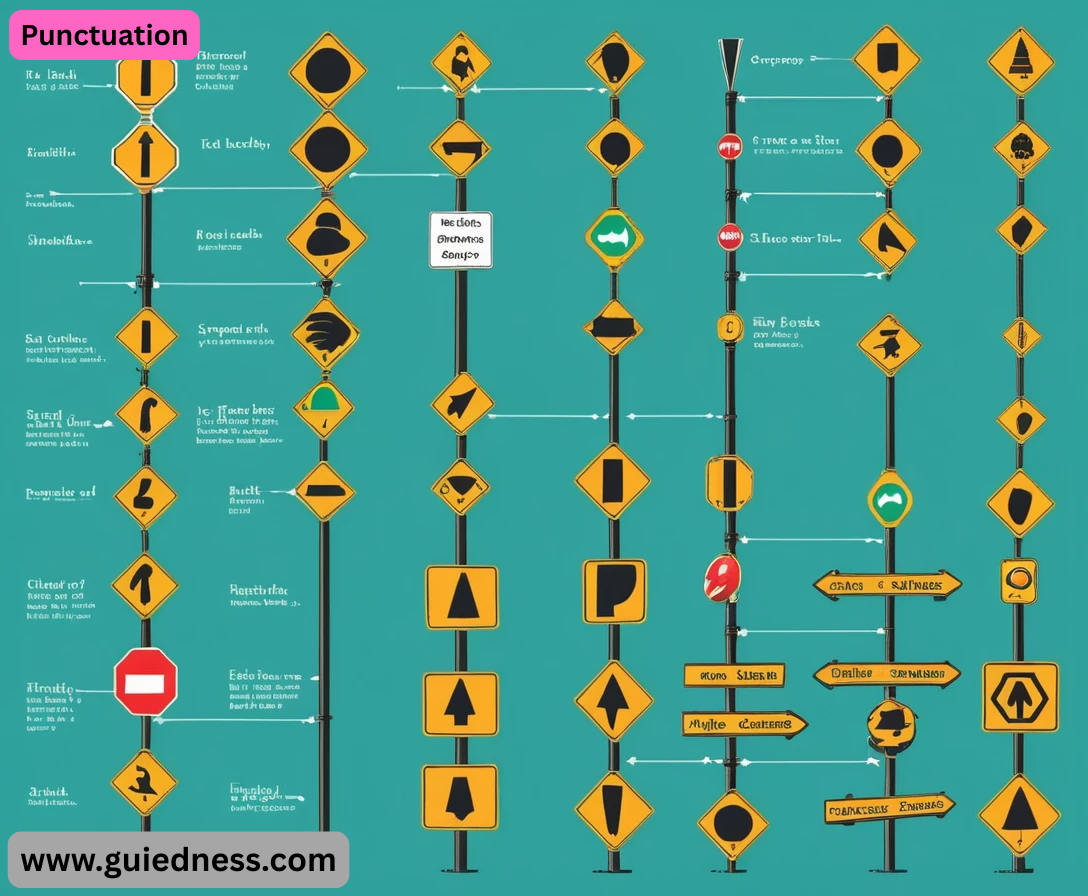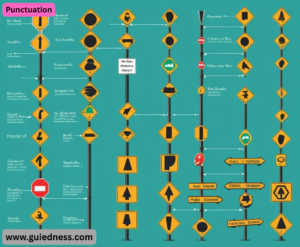Punctuation Of course! Punctuation is the system of symbols used in writing to separate sentences, phrases, and clauses to make the meaning clear.
- Think of it as the traffic signals of language: it tells the reader when to stop, pause, slow down, and how to navigate the flow of ideas.
- Here is a comprehensive guide to the most common punctuation marks in English.
The “Stop” Signs (End Marks)
These marks go at the end of a sentence. Period ( . ) Purpose: Ends a declarative sentence (a statement) or an imperative sentence (a command).
Examples:
- “The sun is shining.” “Please close the door.” Question Mark ( ? ) Purpose: Ends a direct question. Examples: “What is your name?” “Are you coming to the party?”
Exclamation Point ( ! )
- Purpose: Ends a sentence that expresses strong emotion, surprise, or a forceful command.
Examples:
- “Watch out!” “I can’t believe we won!” The “Yield” and “Pause” Signs (Within Sentences)
These marks create pauses and separate ideas within a sentence.
Comma ( , )
- Purpose: The most common and versatile punctuation mark. It indicates a short pause.
Key Uses:
- To separate items in a list: “I bought apples, oranges, and bananas.”
- To connect two independent clauses with a conjunction: “She wanted to go, but it was raining.”
- After an introductory phrase: “After the movie ended, we went for coffee.”
- To set off non-essential information: “My brother, who lives in Paris, is visiting.”
In direct address: “David, can you help me?”
Semicolon ( ; )
- Purpose: Creates a pause stronger than a comma but weaker than a period. It connects closely related ideas.
Key Uses:
- To link two related independent clauses: “The rain stopped; the children ran outside to play.”
- To separate complex items in a list (especially if the items contain commas): “The conference was held in Paris, France; Berlin, Germany; and Rome, Italy.”
Colon ( : )
- Purpose: Introduces something: a list, a quotation, an explanation, or an example.
Key Uses:
- To introduce an explanation or example: “He had one goal: to win.”
- To introduce a quotation: The manager announced: “The store will close early today.”
The “Clarification” Marks
- These marks add extra information or denote specific types of words.
Apostrophe ( ‘ )
- Purpose: Shows possession or forms contractions.
Key Uses:
- Possession: “This is Maria’s book.” / “The dogs’ toys are everywhere.”
- Contractions: “Do not” becomes “don’t.” / “It is” becomes “it’s.”
Quotation Marks ( ” ” )
- Purpose: Enclose direct speech, quotations, and titles of short works (like articles, poems, or songs).
Examples:
- John said, “I’ll be there soon.” My favorite song is “Blinding Lights.” Parentheses ( ( ) )
- Purpose: Enclose additional, non-essential information or an aside.
- Example: “The meeting (which lasted three hours) was finally over.”
Dash ( — )
Purpose: Emphasizes information, indicates an interruption, or sets off a parenthetical thought more forcefully than commas. (There are two types: the en dash – and the em dash —. The em dash is the one most commonly used for this purpose.)
Hyphen ( – )
- Purpose: Connects compound words or joins prefixes in certain cases.
- Examples: “well-being,” “state-of-the-art,” “mother-in-law.”
Why Punctuation Matters
- Incorrect punctuation can completely change the meaning of a sentence. The classic example is the difference between:
- “Let’s eat, Grandma!” (An invitation to your grandmother.)
- “Let’s eat Grandma!” (A suggestion to cannibalize your grandmother.)
- Punctuation saves lives (and grandmas)!
Deep Dive into Common Confusions
1. The Comma: The Oxford Comma Debate
- What it is: The comma used before the conjunction (usually ‘and’ or ‘or’) in a list of three or more items.
- With Oxford Comma: “I invited my parents, Beyoncé, and Barack Obama.” (This implies three separate entities: your parents + Beyoncé + Barack Obama.)
- Without Oxford Comma: “I invited my parents, Beyoncé and Barack Obama.” (This can be misread as your parents are Beyoncé and Barack Obama.)
- Takeaway: While some style guides omit it, using the Oxford comma often prevents ambiguity.
The Semicolon vs. The Colon
- This is a major point of confusion. Remember their core jobs:
- Semicolon ( ; ) is an Equal Sign: It links two independent clauses that are equal in weight and related in thought.
- “She loves reading; her favorite genre is historical fiction.”
- (You could use a period here, but the semicolon shows a stronger connection.)
- Colon ( : ) is a Spotlight: It introduces something that follows, which illustrates, explains, or amplifies what came before the colon.
- “He packed everything he needed: a tent, a sleeping bag, and a map.”
The Apostrophe: Its vs. It’s
- This is the most common punctuation error in the English language.
- It’s is a contraction of “it is” or “it has.”
- Example: “It’s a beautiful day.” / “It’s been raining for hours.”
Example: “The cat chased its tail.”
- How to check: If you can replace “it’s” with “it is” or “it has” in your sentence, you are using the correct form.
Advanced and Specialized Punctuation
12. Ellipsis ( … )
- Purpose: Indicates an omission, a trailing off of thought, or a pause.
Key Uses:
- Omitting Words in a Quote: “The report stated, ‘The results were inconclusive…further study is needed.'”
- Trailing Off in Thought: “I was wondering if maybe you’d like to…never mind.”
- Formal Note: In formal writing, if you omit words from a quotation, an ellipsis is used, often inside square brackets […] to show the omission is yours.
Parentheses ( ) vs. Brackets [ ]
- Parentheses ( ) are for your own additions to a sentence (see above).
- Brackets [ ] are used for clarification within a direct quotation, or inside parentheses to create a nested aside.
- In a Quote: The witness stated, “I saw him [the defendant] enter the building.” (You added “[the defendant]” for clarity.)
- Nested Aside: “The study was conducted in several cities (primarily New York and, to a lesser extent, Boston [see page 42]).”
- 14. The Hyphen (-) vs. The En Dash (–) vs. The Em Dash (—)
This is a typographer’s dream (or nightmare).
- Hyphen ( – ): Connects compound words (as mentioned: well-being, user-friendly).
- It primarily connects ranges of numbers, dates, or times, meaning “to.”
- Examples: “Pages 50–75,” “The years 1990–2000,” “The London–Paris train.”
- Em Dash ( — ): Roughly the width of the letter ‘M’. It’s the one used for the dramatic pauses and asides we discussed earlier.
- Example: “My answer—though you may not like it—is final.”
15. The Slash ( / )
- Purpose: Often means “or” or “and,” or indicates a connection between two things.
Key Uses:
And/Or: “Please bring a notebook and/or a pen.”
- Fractions or Dates: “1/2” (one-half), “He was born in the fiscal year 2023/24.”
- Poetry (Line Breaks): “The woods are lovely, dark and deep, / But I have promises to keep…”
Punctuation for Tone and Style
- Punctuation isn’t just for grammar; it’s a powerful stylistic tool.
- The Em Dash for Drama: It creates a more informal, abrupt, and dramatic pause than commas or parentheses.
Comma: “The truth, however, is hard to hear.”
- Em Dash: “The truth—however—is hard to hear.” (Feels more forceful.)
- The Ellipsis for Hesitation or Suspense: In dialogue or narrative, it can make a character seem uncertain, mysterious, or lost in thought.
“I’m not sure… maybe we shouldn’t go.”
The Exclamation Point for Enthusiasm (Use Sparingly!): Overusing exclamation points can make your writing seem breathless or unprofessional!! See what I mean?! In formal writing, let your words convey the emotion, not the punctuation.



![Parentheses ( ) vs. Brackets [ ]](https://guiedness.com/wp-content/uploads/2025/10/Parentheses-vs.-Brackets--300x247.png)